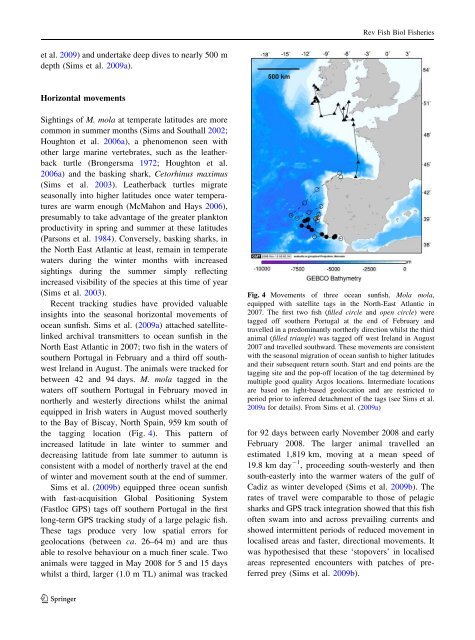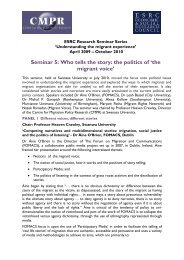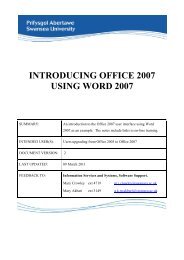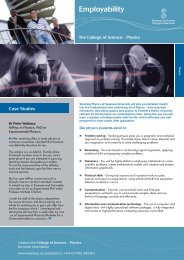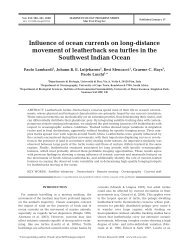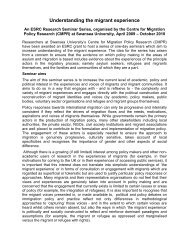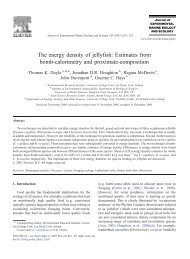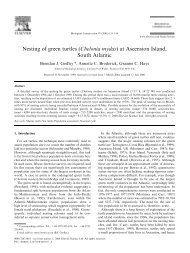The biology and ecology of the ocean sunfish - Swansea University
The biology and ecology of the ocean sunfish - Swansea University
The biology and ecology of the ocean sunfish - Swansea University
You also want an ePaper? Increase the reach of your titles
YUMPU automatically turns print PDFs into web optimized ePapers that Google loves.
Rev Fish Biol Fisheries<br />
et al. 2009) <strong>and</strong> undertake deep dives to nearly 500 m<br />
depth (Sims et al. 2009a).<br />
Horizontal movements<br />
Sightings <strong>of</strong> M. mola at temperate latitudes are more<br />
common in summer months (Sims <strong>and</strong> Southall 2002;<br />
Houghton et al. 2006a), a phenomenon seen with<br />
o<strong>the</strong>r large marine vertebrates, such as <strong>the</strong> lea<strong>the</strong>rback<br />
turtle (Brongersma 1972; Houghton et al.<br />
2006a) <strong>and</strong> <strong>the</strong> basking shark, Cetorhinus maximus<br />
(Sims et al. 2003). Lea<strong>the</strong>rback turtles migrate<br />
seasonally into higher latitudes once water temperatures<br />
are warm enough (McMahon <strong>and</strong> Hays 2006),<br />
presumably to take advantage <strong>of</strong> <strong>the</strong> greater plankton<br />
productivity in spring <strong>and</strong> summer at <strong>the</strong>se latitudes<br />
(Parsons et al. 1984). Conversely, basking sharks, in<br />
<strong>the</strong> North East Atlantic at least, remain in temperate<br />
waters during <strong>the</strong> winter months with increased<br />
sightings during <strong>the</strong> summer simply reflecting<br />
increased visibility <strong>of</strong> <strong>the</strong> species at this time <strong>of</strong> year<br />
(Sims et al. 2003).<br />
Recent tracking studies have provided valuable<br />
insights into <strong>the</strong> seasonal horizontal movements <strong>of</strong><br />
<strong>ocean</strong> <strong>sunfish</strong>. Sims et al. (2009a) attached satellitelinked<br />
archival transmitters to <strong>ocean</strong> <strong>sunfish</strong> in <strong>the</strong><br />
North East Atlantic in 2007; two fish in <strong>the</strong> waters <strong>of</strong><br />
sou<strong>the</strong>rn Portugal in February <strong>and</strong> a third <strong>of</strong>f southwest<br />
Irel<strong>and</strong> in August. <strong>The</strong> animals were tracked for<br />
between 42 <strong>and</strong> 94 days. M. mola tagged in <strong>the</strong><br />
waters <strong>of</strong>f sou<strong>the</strong>rn Portugal in February moved in<br />
nor<strong>the</strong>rly <strong>and</strong> westerly directions whilst <strong>the</strong> animal<br />
equipped in Irish waters in August moved sou<strong>the</strong>rly<br />
to <strong>the</strong> Bay <strong>of</strong> Biscay, North Spain, 959 km south <strong>of</strong><br />
<strong>the</strong> tagging location (Fig. 4). This pattern <strong>of</strong><br />
increased latitude in late winter to summer <strong>and</strong><br />
decreasing latitude from late summer to autumn is<br />
consistent with a model <strong>of</strong> nor<strong>the</strong>rly travel at <strong>the</strong> end<br />
<strong>of</strong> winter <strong>and</strong> movement south at <strong>the</strong> end <strong>of</strong> summer.<br />
Sims et al. (2009b) equipped three <strong>ocean</strong> <strong>sunfish</strong><br />
with fast-acquisition Global Positioning System<br />
(Fastloc GPS) tags <strong>of</strong>f sou<strong>the</strong>rn Portugal in <strong>the</strong> first<br />
long-term GPS tracking study <strong>of</strong> a large pelagic fish.<br />
<strong>The</strong>se tags produce very low spatial errors for<br />
geolocations (between ca. 26–64 m) <strong>and</strong> are thus<br />
able to resolve behaviour on a much finer scale. Two<br />
animals were tagged in May 2008 for 5 <strong>and</strong> 15 days<br />
whilst a third, larger (1.0 m TL) animal was tracked<br />
Fig. 4 Movements <strong>of</strong> three <strong>ocean</strong> <strong>sunfish</strong>, Mola mola,<br />
equipped with satellite tags in <strong>the</strong> North-East Atlantic in<br />
2007. <strong>The</strong> first two fish (filled circle <strong>and</strong> open circle) were<br />
tagged <strong>of</strong>f sou<strong>the</strong>rn Portugal at <strong>the</strong> end <strong>of</strong> February <strong>and</strong><br />
travelled in a predominantly nor<strong>the</strong>rly direction whilst <strong>the</strong> third<br />
animal (filled triangle) was tagged <strong>of</strong>f west Irel<strong>and</strong> in August<br />
2007 <strong>and</strong> travelled southward. <strong>The</strong>se movements are consistent<br />
with <strong>the</strong> seasonal migration <strong>of</strong> <strong>ocean</strong> <strong>sunfish</strong> to higher latitudes<br />
<strong>and</strong> <strong>the</strong>ir subsequent return south. Start <strong>and</strong> end points are <strong>the</strong><br />
tagging site <strong>and</strong> <strong>the</strong> pop-<strong>of</strong>f location <strong>of</strong> <strong>the</strong> tag determined by<br />
multiple good quality Argos locations. Intermediate locations<br />
are based on light-based geolocation <strong>and</strong> are restricted to<br />
period prior to inferred detachment <strong>of</strong> <strong>the</strong> tags (see Sims et al.<br />
2009a for details). From Sims et al. (2009a)<br />
for 92 days between early November 2008 <strong>and</strong> early<br />
February 2008. <strong>The</strong> larger animal travelled an<br />
estimated 1,819 km, moving at a mean speed <strong>of</strong><br />
19.8 km day -1 , proceeding south-westerly <strong>and</strong> <strong>the</strong>n<br />
south-easterly into <strong>the</strong> warmer waters <strong>of</strong> <strong>the</strong> gulf <strong>of</strong><br />
Cadiz as winter developed (Sims et al. 2009b). <strong>The</strong><br />
rates <strong>of</strong> travel were comparable to those <strong>of</strong> pelagic<br />
sharks <strong>and</strong> GPS track integration showed that this fish<br />
<strong>of</strong>ten swam into <strong>and</strong> across prevailing currents <strong>and</strong><br />
showed intermittent periods <strong>of</strong> reduced movement in<br />
localised areas <strong>and</strong> faster, directional movements. It<br />
was hypo<strong>the</strong>sised that <strong>the</strong>se ‘stopovers’ in localised<br />
areas represented encounters with patches <strong>of</strong> preferred<br />
prey (Sims et al. 2009b).<br />
123


